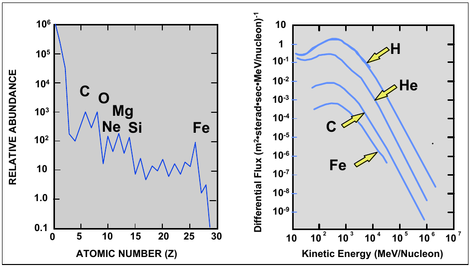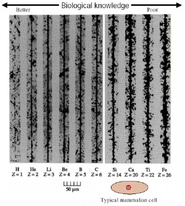Difference between revisions of "Heavy Ions"
m (Minor corrections.) |
m (Added health effects information.) |
||
| Line 8: | Line 8: | ||
==Health Effects== | ==Health Effects== | ||
| + | Heavy ions passing through cells transfer more energy into a small volume, compared to other components of cosmic radiation. This concentrated effect can produce qualitatively different types of cell damage.<ref name=":0">Cucinotta FA, Durante M. (2009). Risk of Radiation Carcinogenesis. In ''Human Health and Performance Risks of Space Exploration Missions''. NASA-SP-2009-3405. <nowiki>https://humanresearchroadmap.nasa.gov/Evidence/reports/EvidenceBook.pdf</nowiki></ref> | ||
| + | [[File:Cucinotta 2009 Fig. 4-3.png|none|thumb|206x206px|<ref name=":0" />Comparison of the ionization effects on nearby molecules produced by ions with different masses.]] | ||
| + | |||
| + | The health effects of high doses of other types of radiation have been studied by analyzing the health of exposed groups (for example, survivors of nuclear weapon attacks or nuclear power plant accidents). However, in the case of heavy ion radiation, estimates of the risk to astonauts are derived solely from animal model studies and application of biophysics principles. As a result, these estimates are less certain.<ref name=":0" /> | ||
==Shielding Considerations== | ==Shielding Considerations== | ||
| − | == References == | + | ==References== |
<references /> | <references /> | ||
Revision as of 16:34, 31 July 2018
Heavy ions are charged particles heavier than alpha particles.[1] They consitute 1% of cosmic radiation.[2]
Exposures

[3]Abundances and energies of heavy ions in cosmic radiation.
Health Effects
Heavy ions passing through cells transfer more energy into a small volume, compared to other components of cosmic radiation. This concentrated effect can produce qualitatively different types of cell damage.[4]

[4]Comparison of the ionization effects on nearby molecules produced by ions with different masses.
The health effects of high doses of other types of radiation have been studied by analyzing the health of exposed groups (for example, survivors of nuclear weapon attacks or nuclear power plant accidents). However, in the case of heavy ion radiation, estimates of the risk to astonauts are derived solely from animal model studies and application of biophysics principles. As a result, these estimates are less certain.[4]
Shielding Considerations
References
- ↑ Heavy ion. (1998, Jul 20). In Encyclopaedia Britannica. https://www.britannica.com/science/heavy-ion
- ↑ Schimmerling W. (2011, Feb 5). The Space Radiation Environment: An Introduction. https://three.jsc.nasa.gov/concepts/SpaceRadiationEnviron.pdf
- ↑ Schimmerling W. (2011, Feb 5). The Space Radiation Environment: An Introduction. https://three.jsc.nasa.gov/concepts/SpaceRadiationEnviron.pdf
- ↑ 4.0 4.1 4.2 Cucinotta FA, Durante M. (2009). Risk of Radiation Carcinogenesis. In Human Health and Performance Risks of Space Exploration Missions. NASA-SP-2009-3405. https://humanresearchroadmap.nasa.gov/Evidence/reports/EvidenceBook.pdf






